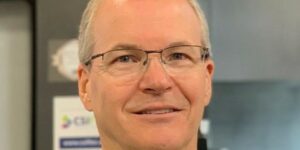ULSTRASONIC MACHINING OF GLASS CERAMIC COMPOSITES
A look at how ASML Optics uses DMG machines and Siemens controls to efficiently machine components for the semiconductor industry, including wafer stepper and scanner machines.
Posted: September 28, 2011
A look at how this high tech machine shop uses cutting edge systems and advanced controls to efficiently machine components for the semiconductor industry, including wafer stepper and scanner machines.
Through the use of ultrasonic machining on various glass ceramic composites, including Zerodur®1, the ASML Optics group (Richmond, CA) has significantly improved its productivity, according to company sources. This highly advanced facility supplies its parent company, ASML (Veldhoven, The Netherlands), with a variety of components used in its advanced systems and equipment builds for the semiconductor industry, including wafer stepper and scanner machines.
Zerodur is an extremely expensive raw material with the necessary properties required by the high-accuracy applications of the semiconductor industry. The machinery produced by ASML is utilized by semiconductor manufacturers in their critical lithography operations to image circuit patterns in photoresist on silicon wafers in the chip production process. A new ASML technology, TWINSCAN, images one wafer while simultaneously measuring the next one. The parts produced from Zerodur by the ASML Optics Group, therefore, must attain consistently uniform tolerances, less than 10 microns.
ASML has been machining glass materials for years, but concluded that it needed to increase its productivity without sacrificing the extremely tight tolerances held in its machining processes. Often, the prototyping process at this facility leads quickly to a production run, once the prototype has been found suitable for the application. Given the difficulty in machining Zerodur, an entirely new approach was required, that would render fast material removal while maintaining superior accuracy.
The ASML Optics group reviewed numerous technologies and other ultrasonic machine tool suppliers before deciding upon the Ultrasonic 50 and Ultrasonic 70 from DMG America (Schaumburg, IL), two machines that offered the flexibility for three-axis and five-axis machining, in both ultrasonic and conventional milling machine modes. Onboard each of these machine tools is the Siemens Sinumerik 840D powerline CNC that has the capability for quick programming and set-up in either machining mode.
In the ultrasonic mode, the Adaptive Control and Acoustic Control features of the CNC combine with its open architecture design to effectively monitor the machining action and quickly adjust the feed and spindle speeds to maintain predictable accuracies to the desired levels of this demanding customer environment. Adaptive Control monitors the process forces on the machining tool, while the Acoustic Control registers the intensity of the tool vibration on the workpiece surface via an electrical echo signal, as well as the status of the coolant pressure. Special HSK 63-S tool fittings on the machine tools further enable the changeover from conventional milling to ultrasonic machining mode.
“The significant improvement in the shop’s productivity stems from the recent on streaming of this new ultrasonic machining equipment,” said Matthew White, ASML Optics manufacturing manager. Ultrasonic machining technology involves the machining spindle creating an oscillation that causes the diamond tool to pulse with a controlled frequency between 17,500 and 48,000 times per second, depending on the spindle type used. This action removes micro-particles from the material surface, at a rate approximately five times that of conventional machining, especially on such advanced composite materials as Zerodur.
According to DMG national product manager for ultrasonics Erich Bertsche, the permanent gap between the tool and the work piece leads to significant reduction in the heat stress and the work force required, thus conserving the tool life and the work piece material integrity. An inductive spool that functions as the transmitter is affixed to the tool interface underneath the spindle head. On the HSK 63-S fitting itself is another spool that functions as the receiver.
As a result of the ultrasonic stimulation, the diamond tool kernels contact the work piece surface with a controlled force, thereby removing the material in a very precise and predictable manner. In the semiconductor industry, this machining technique is frequently used to work silicon, silicon carbide, silica glass and glass ceramic composites such as Zerodur, holding extremely tight dimensions with surface finish to 0.2µm (0.000008 in) or better being the standard.
White noted that “our group works in various advanced material compositions. The challenges of Zerodur, as well as others, required us to look for a new machining strategy to maintain our manufacturing standards while continuing to supply our parent company with the necessary part production. We saw substantial upsides to the these Ultrasonic machines and continue to find new and better ways to use them for the improvement of our overall process here at ASML. These machines have simply ramped up our productivity by a factor of five, compared to the previous technology we utilized. This machine tool supplier also provides us the special tooling needed to machine Zerodur.”
Bertsche explained how his company has a special Sauer galvanizing and sintering process, used to create the diamond tools for ultrasonic machining. Through this process, a unique binding matrix keeps the diamond kernels precisely in place during continuous tool oscillation.
ASML does its own programming on its ultrasonic machines. In this effort, it utilizes one unique benefit of the Siemens machine control technology, namely, the Swivel Cycle. White explained how “we set up the origin of the part and the Swivel Cycle allows for rotational shift of the coordinate system, XYZ transitional, with no separate work offsets needed. Where once we needed four set-ups over three machines, we can now perform two set-ups on one chuck on one Ultrasonic machine. The time savings are incredible.”
As part of the ShopMill suite, the Swivel Cycle has a menu-driven feeler function for determining the zero-point offset, even in swiveled five-axis machining planes. It allows flexible input of the swivel angles in a work piece coordinated system, including axis angle, solid angle and angle of projection. This means both the programming and the set-up time are significantly reduced. For a job with numerous one-off or small batches made from extremely costly materials, this feature further expands job potential, while substantially speeding up throughput.
Bertsche also noted the cooperation with the Siemens team in developing the HMI has resulted in faster training on the machines through using standard M-code actuation of the ultrasonic on/off, standard ISO code, plus the onboard Adaptive and Acoustic Control programs. The unique DMG set-up of all parameters is done seamlessly as another window within the standard Siemens CNC screen array.
Essentially, the concept of open architecture on the Sinumerik 840D CNC enables the machine builder to program its own functionality into the NC kernel. According to Bertsche, this design in the CNC supports the customer with more flexibility in set-up strategies, faster cycle and reaction times. Since the machining process is continuously monitored, unattended machining is possible, even in the high-precision, small batch runs.
As an example, intelligent control algorithms typically regulate the feed rate while machining an inside radius. Usually, process force increases, even if the other parameters remain static, owing to the high angle of content. As Bertsche noted, this control recognizes these contours and automatically adjusts the feed rate to maintain correct cutting conditions. Also, with the touch of one button, an ASML operator can call up the ultrasonic generator screen and all variables can be quickly adjusted, including ultrasonic frequency, amplitude and output, or the operator can automatically adjust the output for a defined number of tools in the automatic tool changer.
ASML is the first manufacturer in the U.S. to be cutting Zerodur with Ultrasonic machines. Other manufacturers are using Ultrasonic machines to produce parts made from advance composites and other non-conductive materials in the brake, aerospace, optics and medical/orthopedic market segments, in addition to the semiconductor manufacturing equipment sector.
1 Zerodur® is a registered trademark of Schott AG in Germany.
Siemens Industry, Inc., Drive Technologies, Motion Control Machine Tool Business, 390 Kent Avenue, Elk Grove Village, IL 60007, 847-640-1595, Fax: 847-437-0784, www.SiemensCNC.com, SiemensMTBUMarCom.sea@siemens.com.
DMG America, 242 South Dean Street, Englewood, NJ 07631, 201-894-5505, Fax: 201-894-0213, www.dmgmoriseikiusa.com.



